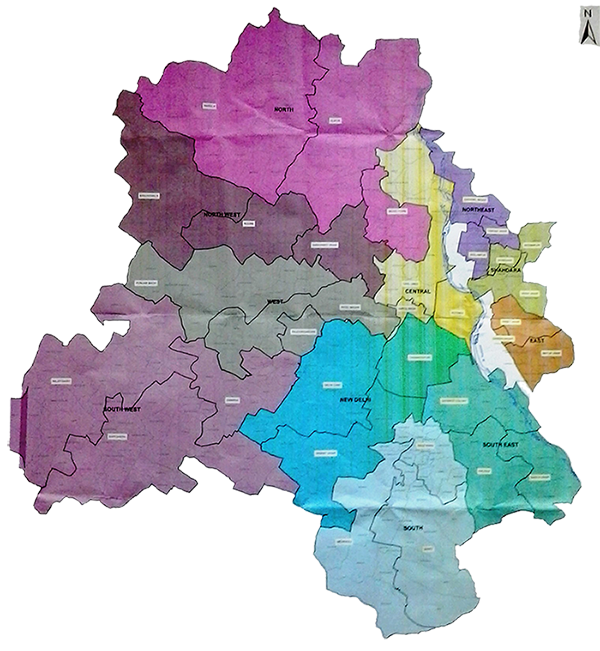

| Sl | District Name | Headquarters | Sub-Divisions | ||
| 1 | New Delhi | Jamnagar House | Chanakyapuri | Delhi Cantonment | Vasant Vihar |
| 2 | Central Delhi | Daryaganj | Civil Lines | Karol Bagh | Kotwali |
| 3 | East Delhi | Shastri Nagar | Gandhi Nagar | MayurVihar | Preet Vihar |
| 4 | North Delhi | Alipur | Alipur | Model Town | Narela |
| 5 | North East Delhi | NandNagri | Karawal Nagar | Seelampur | Yamuna Vihar |
| 6 | North West Delhi | Kanjhawala | Kanjhawala | Rohini | Saraswati Vihar |
| 7 | Shahdara | Nand Nagri | Seemapuri | Shahdara | Vivek Vihar |
| 8 | South Delhi | Saket | HauzKhas | Mehrauli | Saket |
| 9 | South East Delhi | Lajpat Nagar | Defence Colony | Kalkaji | Sarita Vihar |
| 10 | South West Delhi | Kapashera | Dwarka | Kapashera | Najafgarh |
| 11 | West Delhi | Shivaji Place | Patel Nagar | Punjabi Bagh | Rajouri Garden |
| Rural Blocks | Mehrauli, Alipur, Najafgarh, Tis Hazari, Nangloi, Nand Nagri and L.M.Bandh | ||||
|---|---|---|---|---|---|
| Demographic Area | 1483 Sq. Km. | ||||
| Rural Area | 558.32 Sq Km. | ||||
| Urban Area | 924.68 Sq. Km. | ||||
| Total Population (as per 2011) | 168 Lacs |
| Male | 90 Lacs |
| Female | 78 Lacs |
| Urban Population | 4 Lacs |
| Rural Population | 164 Lacs |
| Population Density | 11320 |
| Per Capita Income | Rs.61676 |
| Literacy | 86.21% |
| State Borders | Haryana & Uttar Pradesh |
| River | Yamuna |
| Annual Rainfall | 714 mm. |
| Minerals | Sand & Sand Stone |
| Historical & Tourist Places | Lal Quila, Qutab Minar, Jama Masjid, India Gate, Purana Kila, Jantar Mantar, Parliament House, Humayon Tomb, Nizamuddin Dargah, Birla Mandir and Lotus Temple etc |
Delhi (NCT) is the largest metropolis by area and the second-largest metropolis by population in India. It is the eighth largest metropolis in the world by population with 16.7 million inhabitants in the Territory as per 2011 Census
Delhi is an important territory as far as banking developments are considered. It has a well spread network of more than 2800 bank branches. With Rs 7,11,039 crores of deposits and Rs 7,25,012 crores of advances Delhi ranks second, after Maharashtra, among all states in terms of total banking business.
Delhi's economy is characterized by public and private sectors comprising of industries providing financial services, manufacturing industries, media and mass communication. The tertiary sector contributes 70.95% of Delhi's gross SDP followed by secondary and primary sectors, with 25.20% and 3.85% contribution, respectively. Key service industries include information technology, telecommunications, hotels, banking, media and tourism. Delhi's manufacturing industry has also grown considerably as many consumer goods industries have established manufacturing units and headquarters in and around Delhi. Delhi's large consumer market, coupled with the easy availability of skilled labour, has attracted foreign investment.
Construction, power, telecommunications, health and community services, and real estate form integral parts of Delhi's economy. Delhi has India's largest and one of the fastest growing retail industries. As a result, land prices are booming and Delhi is currently ranked the 7th most expensive office hotspot in the world.
Delhi has seen major infrastructural changes over the past few years amidst increased foreign investment and economic growth. Delhi's infrastructure is attracting MNCs and corporate bodies from all over the world.
Information technology, BPOs and other IT Services are among the growing industries in Delhi.
Recent developments and economical growth in Delhi have put the city on the global map competing with other top notch cities in the world.
Delhi has a much improved infrastructure with Delhi Metro connectivity, new roads, flyovers, bridges, healthcare facilities, sanitation, etc. Education in Delhi has always been the specialty of Delhi with so many good schools and colleges to choose from.
Other major initiatives of the Government include telecom, housing, power facilities, and transportation.
The Geographical area of Delhi is 1483 sq. kms. Out of this area about 790 sq.km. is under rural belt, which is divided into 7 community blocks and 220 village. Delhi being a Metropolitan city, the role of agriculture in the economy of Delhi has been relegated over the past few years due to various reasons, such as migration of population from rural area, conversion of agricultural land into commercial/residential areas as well as rapid urbanization, as a result agriculture sector has declined over the last two decades. About 40000 families consisting of 90% small and marginal farmers are cultivating about 45000 hectare land in rural area of Delhi.
During the 9th Five Year Plan concerted efforts were during the 9th Five Year Plan concerted efforts were made by the Govt. of NCT of Delhi for increasing production and productivity in agriculture sector and Rural Development sector by implementing 21 schemes keeping in view the concept of employment and income generating factor from per unit of land. Emphasis was given for vegetable, mushroom, floriculture cultivation besides development of community parks and gardens. Government has taken various measures to shift the farmers from conventional agriculture to high value commercial agriculture by boosting them for cultivation of commercial crops with focus on vegetable production, floriculture, mushroom cultivation etc.